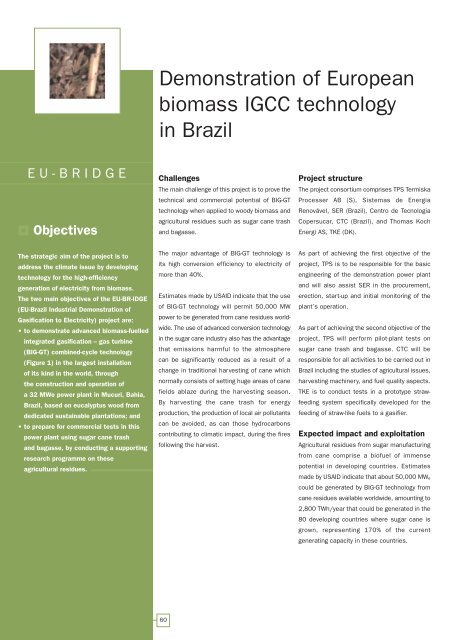European Bio-Energy Projects
European Bio-Energy Projects
European Bio-Energy Projects
Create successful ePaper yourself
Turn your PDF publications into a flip-book with our unique Google optimized e-Paper software.
EU-BRIDGE<br />
Objectives<br />
The strategic aim of the project is to<br />
address the climate issue by developing<br />
technology for the high-efficiency<br />
generation of electricity from biomass.<br />
The two main objectives of the EU-BR-IDGE<br />
(EU-Brazil Industrial Demonstration of<br />
Gasification to Electricity) project are:<br />
• to demonstrate advanced biomass-fuelled<br />
integrated gasification – gas turbine<br />
(BIG-GT) combined-cycle technology<br />
(Figure 1) in the largest installation<br />
of its kind in the world, through<br />
the construction and operation of<br />
a 32 MWe power plant in Mucuri, Bahia,<br />
Brazil, based on eucalyptus wood from<br />
dedicated sustainable plantations; and<br />
• to prepare for commercial tests in this<br />
power plant using sugar cane trash<br />
and bagasse, by conducting a supporting<br />
research programme on these<br />
agricultural residues.<br />
Demonstration of <strong>European</strong><br />
biomass IGCC technology<br />
in Brazil<br />
Challenges<br />
The main challenge of this project is to prove the<br />
technical and commercial potential of BIG-GT<br />
technology when applied to woody biomass and<br />
agricultural residues such as sugar cane trash<br />
and bagasse.<br />
The major advantage of BIG-GT technology is<br />
its high conversion efficiency to electricity of<br />
more than 40%.<br />
Estimates made by USAID indicate that the use<br />
of BIG-GT technology will permit 50,000 MW<br />
power to be generated from cane residues worldwide.<br />
The use of advanced conversion technology<br />
in the sugar cane industry also has the advantage<br />
that emissions harmful to the atmosphere<br />
can be significantly reduced as a result of a<br />
change in traditional harvesting of cane which<br />
normally consists of setting huge areas of cane<br />
fields ablaze during the harvesting season.<br />
By harvesting the cane trash for energy<br />
production, the production of local air pollutants<br />
can be avoided, as can those hydrocarbons<br />
contributing to climatic impact, during the fires<br />
following the harvest.<br />
60<br />
Project structure<br />
The project consortium comprises TPS Termiska<br />
Processer AB (S), Sistemas de Energia<br />
Renovável, SER (Brazil), Centro de Tecnologia<br />
Copersucar, CTC (Brazil), and Thomas Koch<br />
Energi AS, TKE (DK).<br />
As part of achieving the first objective of the<br />
project, TPS is to be responsible for the basic<br />
engineering of the demonstration power plant<br />
and will also assist SER in the procurement,<br />
erection, start-up and initial monitoring of the<br />
plant’s operation.<br />
As part of achieving the second objective of the<br />
project, TPS will perform pilot-plant tests on<br />
sugar cane trash and bagasse. CTC will be<br />
responsible for all activities to be carried out in<br />
Brazil including the studies of agricultural issues,<br />
harvesting machinery, and fuel quality aspects.<br />
TKE is to conduct tests in a prototype strawfeeding<br />
system specifically developed for the<br />
feeding of straw-like fuels to a gasifier.<br />
Expected impact and exploitation<br />
Agricultural residues from sugar manufacturing<br />
from cane comprise a biofuel of immense<br />
potential in developing countries. Estimates<br />
made by USAID indicate that about 50,000 MWe<br />
could be generated by BIG-GT technology from<br />
cane residues available worldwide, amounting to<br />
2,800 TWh/year that could be generated in the<br />
80 developing countries where sugar cane is<br />
grown, representing 170% of the current<br />
generating capacity in these countries.

















